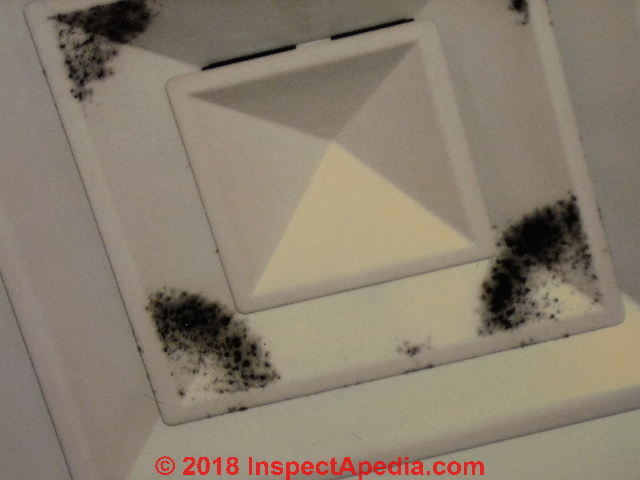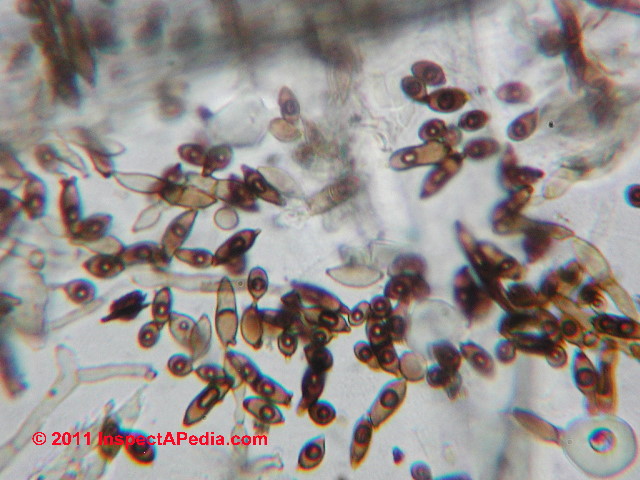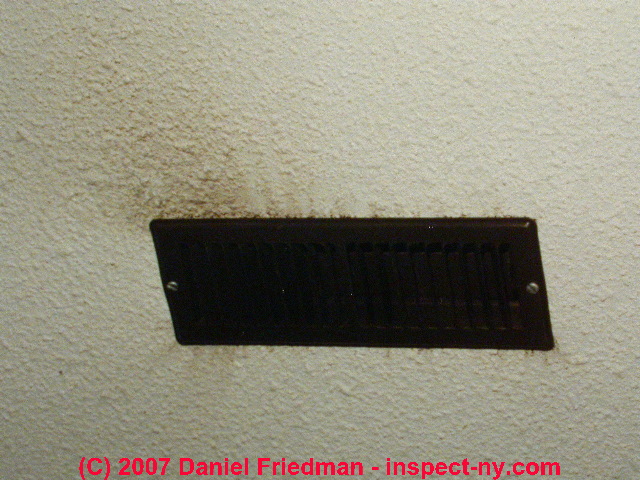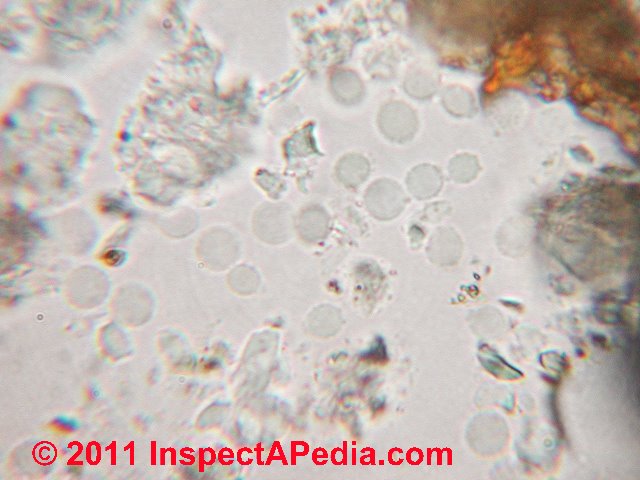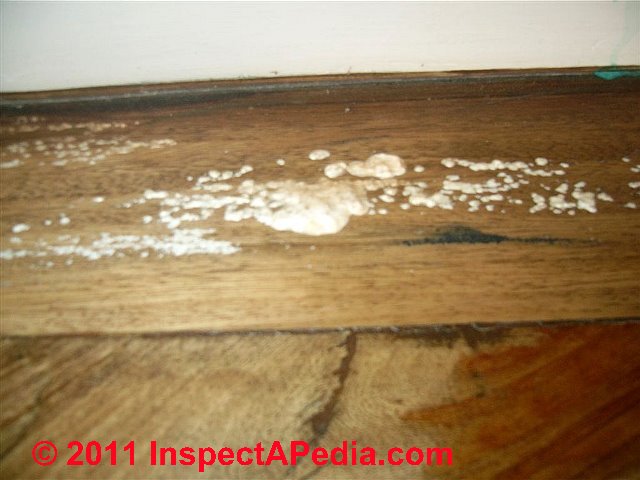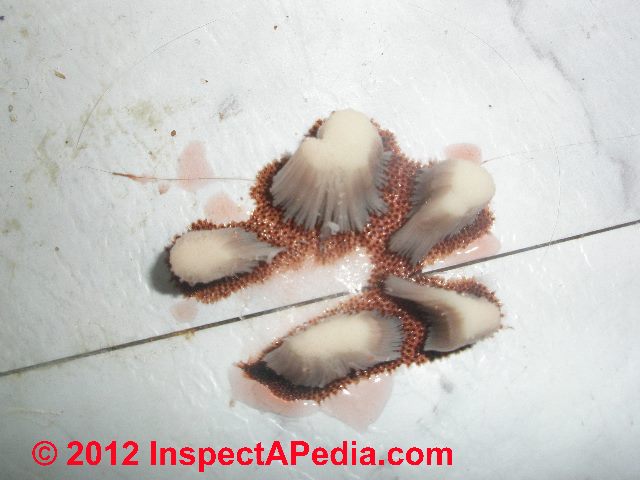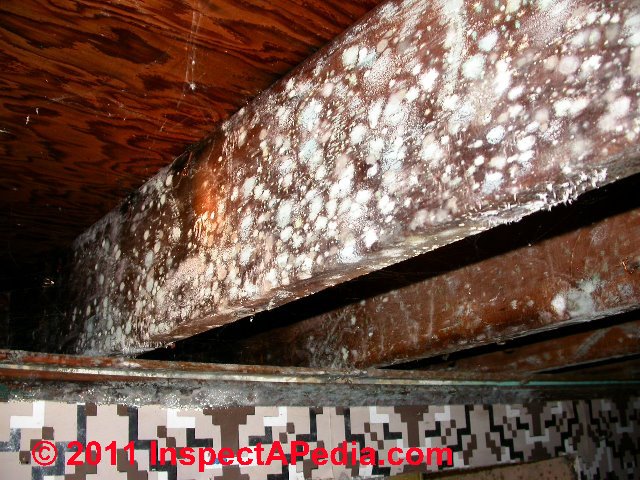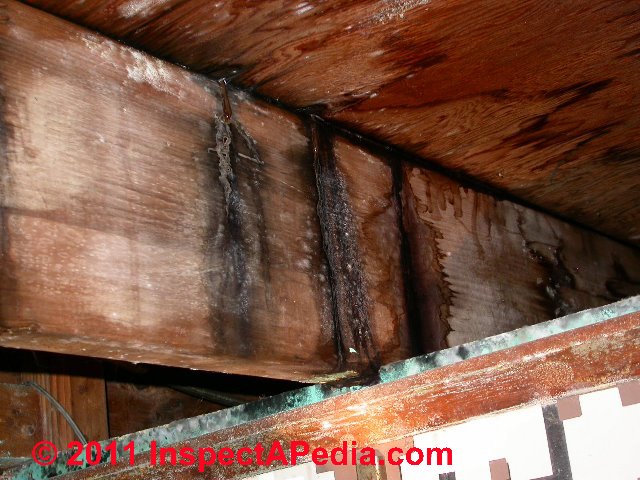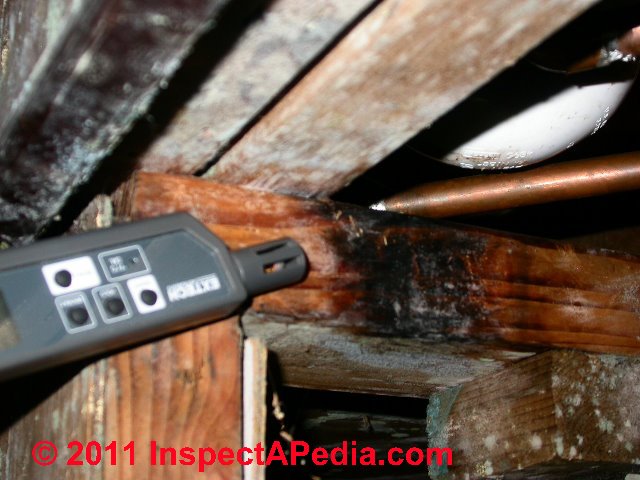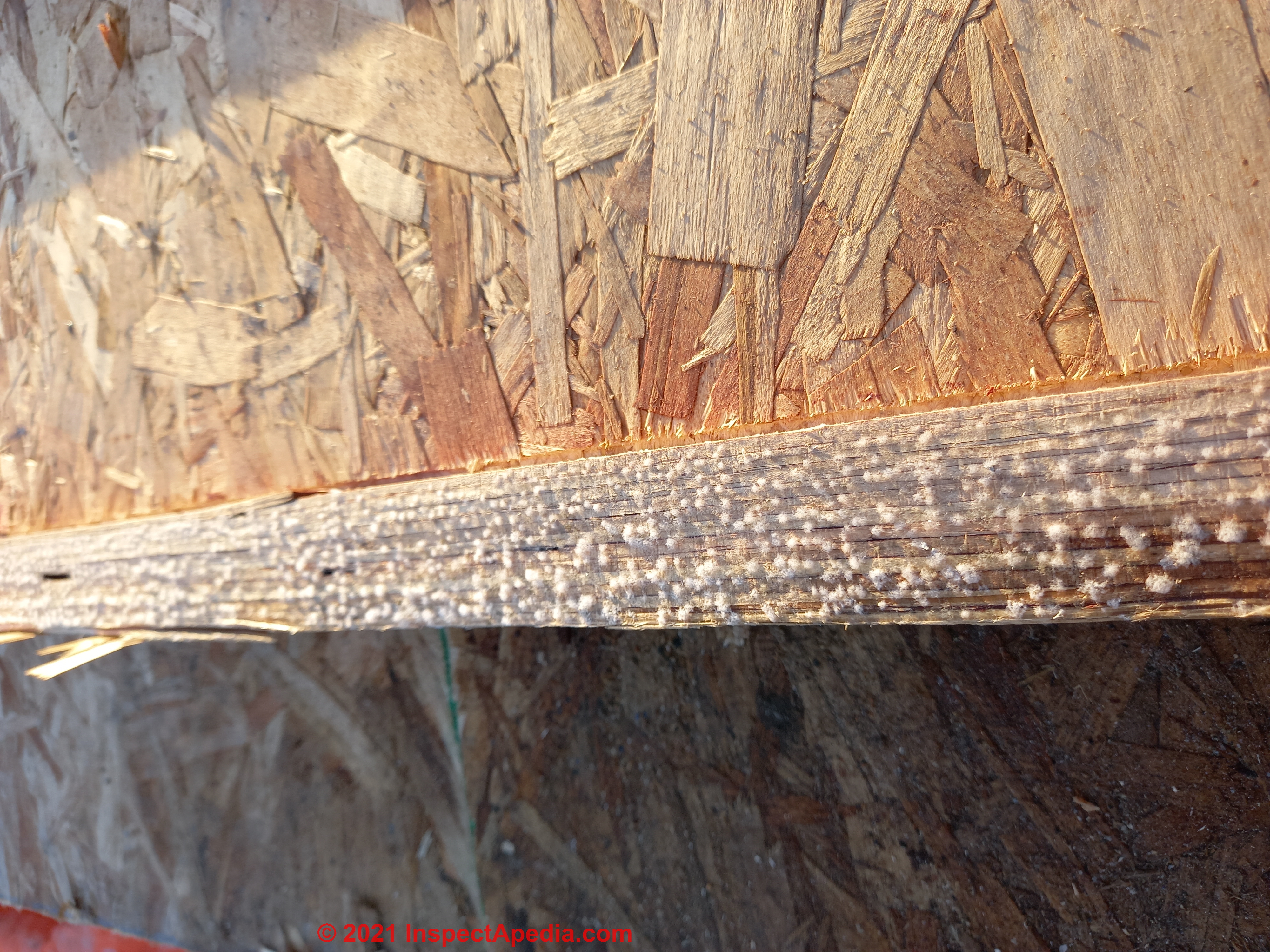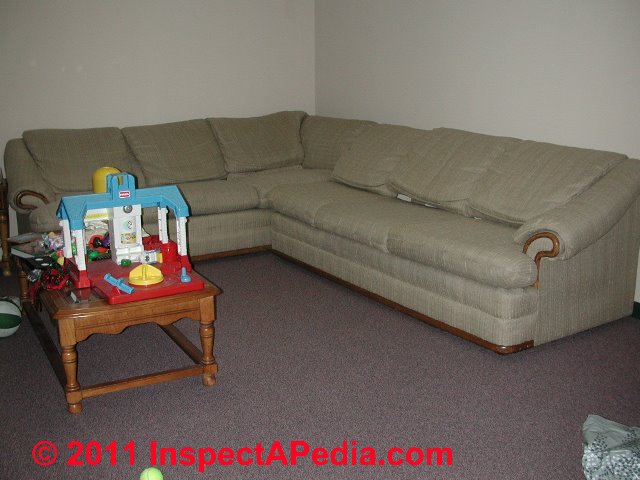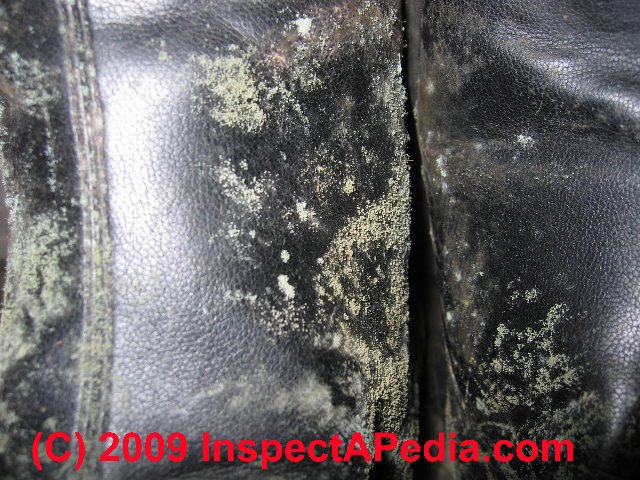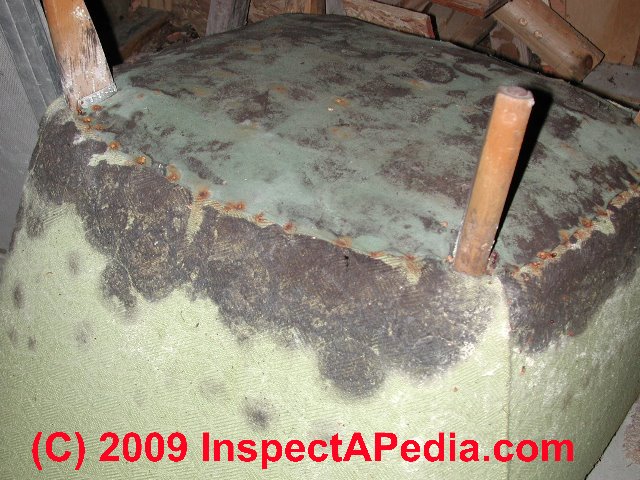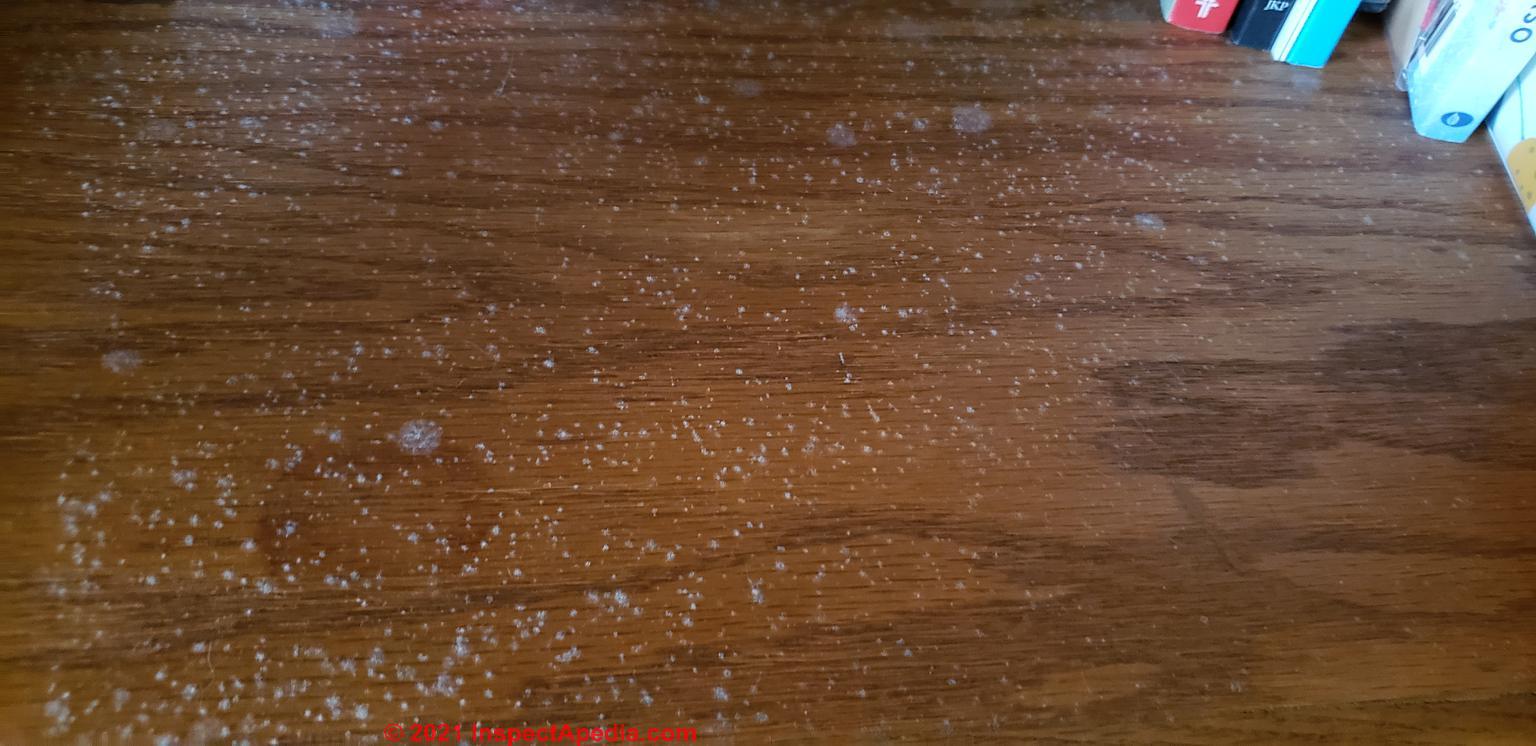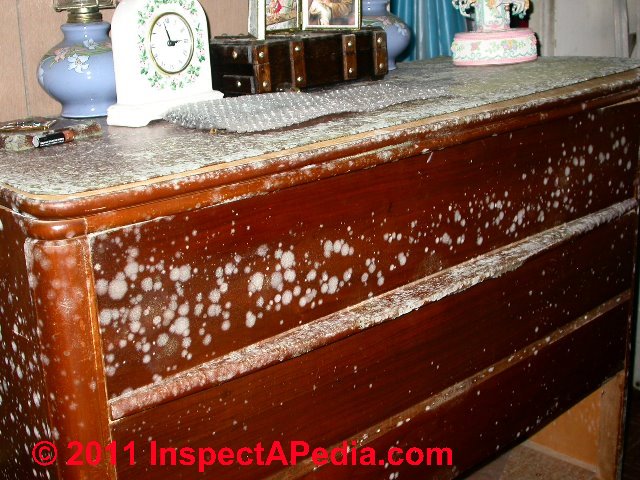 Mold In-Situ: Photos of Mold on Surfaces - Group 5
Mold In-Situ: Photos of Mold on Surfaces - Group 5
What Mold Looks Like
Ductwork
In Dust
On Flooring
On Framing
- POST a QUESTION or COMMENT about what mold looks like in buildings, including mobile homes and trailers
Photographs of mold growth in buildings:
Here is our expert's photo guide to mold commonly found in indoor dust samples, mold on plumbing fixtures & ceramic surfaces, mold in flex-duct, mold on floor tiles, mold on floor trim, mold on resilient flooring or sheet flooring, mold on wood flooring, mold on framing lumber, mold on and in furniture.
These photos of mold on indoor various materials or "mold growth substrates" may help you recognize mold in buildings, recognize probably-cosmetic mold, and recognize stuff that is not mold and does not need to be tested.
The author has worked as a building & environmental inspector since the 1970s and has been a member of the American Industrial Hygiene Association (AIHA) and is a member of ASHRAE, American Society of Heating, Refrigerating, and Air-Conditioning Engineers.
InspectAPedia tolerates no conflicts of interest. We have no relationship with advertisers, products, or services discussed at this website.
- Daniel Friedman, Publisher/Editor/Author - See WHO ARE WE?
Pictures of Mold on Various Building Surfaces and Materials
Here we provide a large collection of in-situ photographs of all types of mold growths found in buildings. For page loading speed we have divided this article into several sections.
Use the link
MOLD APPEARANCE on VARIOUS SURFACES - INDEX
to return to the index / list of photographs of the appearance of mold on various building materials & contents.
A photographic guide to the appearance of mold as it is found growing on more than 100 indoor building surfaces and materials such as building contents, furnishings, trim, walls, wood, and personal or even plastic items found in buildings.
Mold commonly found in indoor dust samples, mold on plumbing fixtures & ceramic surfaces, mold in flex-duct, mold on floor tiles, mold on floor trim, mold on resilient flooring or sheet flooring, mold on wood flooring, mold on framing lumber, mold on and in furniture.
-- MOLD GROWTH on MATERIAL SURFACES PHOTOS GROUP 5 --
- MOLD on/in DUCTWORK - see MOLD on/in AIR DUCTS in HVAC SYSTEMS
- MOLD on DUCT SUPPLY or RETURN REGISTERS
- MOLD in DUST SAMPLES
- MOLD on FIXTURES, PLUMBING
- MOLD on FLEX DUCT
- MOLD on FLOOR TILES
- MOLD on FLOOR TRIM
- MOLD on FLOORING, RESILIENT
- MOLD on FLOORING, WOOD
- MOLD on FRAMING LUMBER, Joists, Studs, I-Joists
- MOLD on FURNITURE
Photographs of mould found on the surface of items, materials, & surfaces found indoors
Mold on Duct Supply or Return Registers
[Click to enlarge any image]
Above: mold growth at the corners of an air supply register in a building ceiling.
Watch out: deposits of normal building dust, primarily composed of skin cells and fabric fibers, are common at air supply and return registers and are often mistaken for mold.
Help distinguishing dust deposits from mold is given
In that document we report on an examination of samples from the ceiling register shown above:
In response to a history of a building leak event and odor complaints as well as the appearance of mold on some building walls, we analyzed samples of the dust from the ceiling air supply register shown at left.
Below you can see that the dominant particle in the sample was Cladosporium sp. C. sphaerospermum spores were also present in this sample.
In contrast with the example above, the air supply register below shows more normal house dust deposit patterns. This is not mold.
Also see AIRBORNE PARTICLE & MOLD LEVELS in DUCTWORK where we describe how to test HVAC systems and ductwork for mold.
Below: white deposits that look like mold growth on fiberglass HVAC duct liner, also discussed in the article linked just above. There we rule out efflorescence and we discuss the possibility of white drywall dust deposits in ductwork.
Mold in Dust samples
It is expected to find mold spores in indoor dust samples in most buildings. Typically in a building without an indoor mold reservoir the dust samples reflect spores that are also found in outdoor air.
But when we find Pen/Asp spore chains or clusters such as shown in our dust particle photographs below, we suspect that there is a nearby problem mold reservoir in the building.
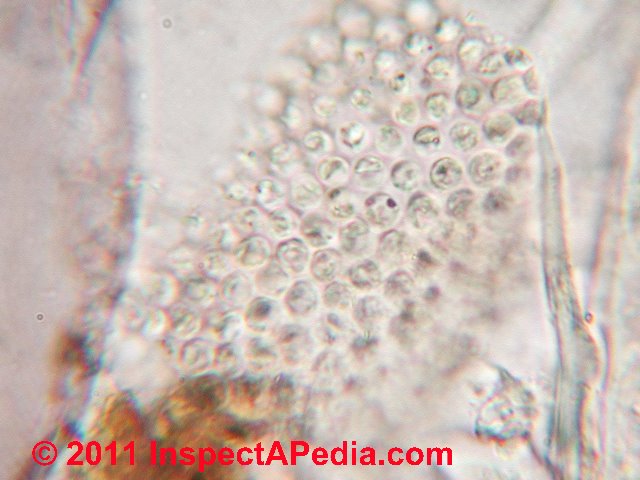
Both Aspergillus sp. and Penicillium sp. spore chains are fragile enough that they normally break into individual spores quickly as the spores are released from the conidiophore and travel through air. So when we see spores that are still "stuck" together, we figure that the spore source must be close by.
Mold on Fixtures, Plumbing
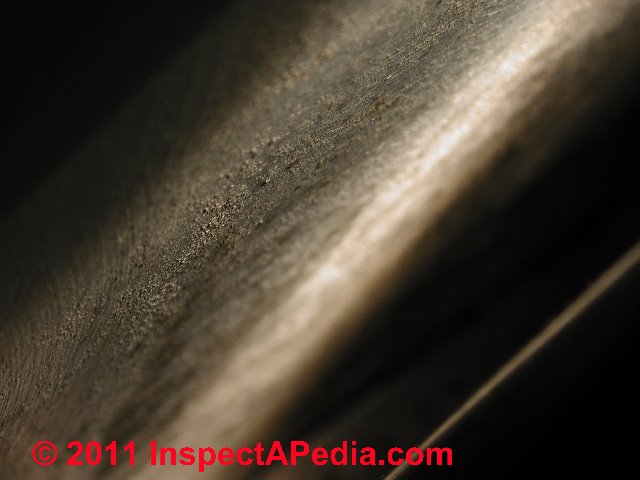
This photograph illustrates mold growth on the black ceramic surface of a toilet. We suspect that mold growth on this surface was due to the presence of organic dust and debris.
We also find mold growth in dirty toilet bowls, a topic that should not need elaboration.
Mold on Flex-Duct flexible HVAC ductwork
Usually what we see in flexduct is an accumulation of house dust; that dust contains lots of organics (skin cells, for example) but is generally harmless until it gets wet. Then the dust becomes a picnic for various fungi.
This flex duct should be replaced.
Cleaning flex duct is pretty futile given the fragility of the material and its often inaccessible sections.
Information about moldy air handlers and ductwork is
at AIRBORNE PARTICLE & MOLD LEVELS in DUCTWORK
and
See AIRBORNE PARTICLE & MOLD LEVELS in DUCTWORK - [technical article] for an analysis of what's typically found in HVAC ducts
Mold on Floor Tiles & Resilient Flooring
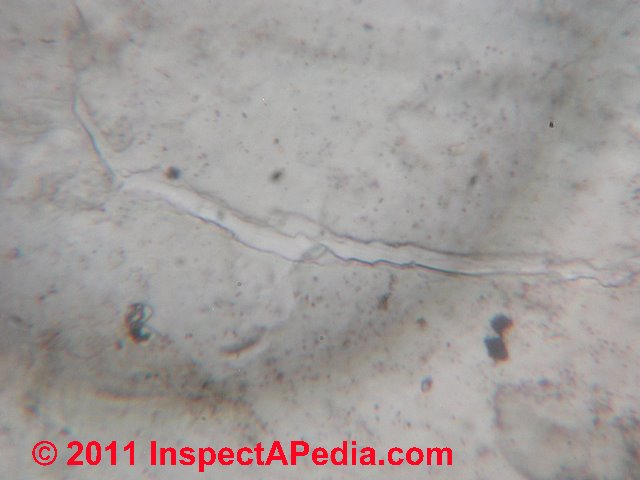
Absence of evidence of mold is not evidence that no mold is present in the building. This photograph illustrates a debris sample collected from the vinyl-asbestos-tiled floor in the main sanctuary of a church where there was a moderate mold problem in the church basement.
What we saw was floor wax and non-fungal granular debris.
On occasion we do find fungal growth on both vinyl floor tiles and on other resilient floor surfaces that have been wet, especially if there is also food waste or other organic debris present.
We also find mold growth on the softer paper-like backing on resilient flooring that has been subjected to protracted leaks or flooding.
Mold on & Mushrooms Growing Out of Floor Trim
Watch out: as we warn
the quantity of visible mold may be trivial and the species harmless or just allergenic, but when we find mushrooms growing out of floor trim we know there has been a history of flooding or recurrent leaks - and we look for both hidden mold colonization and hidden structural damage.
Also see MOLD on TRIM, WOOD.
And since floor baseboard trim is sometimes made of rubber or vinyl, also see MOLD on RUBBER for other examples of mold growth on rubber and see MOLD on VINYL WINDOWS for examples of mold growth on vinyl.
Mold on Flooring, Wood
Our moldy wood flooring photo at below-left is a clue that there was a history of leaks at the exterior door. In fact an inspection of the crawl area below this room found extensive rot and mold damage - the mold-stained flooring in this photograph had been re-finished with a clear coating, but the damage continued below.
Below is another example of "fixing" a moldy floor by simply coating over the mold with a clear floor re-finishing compound.
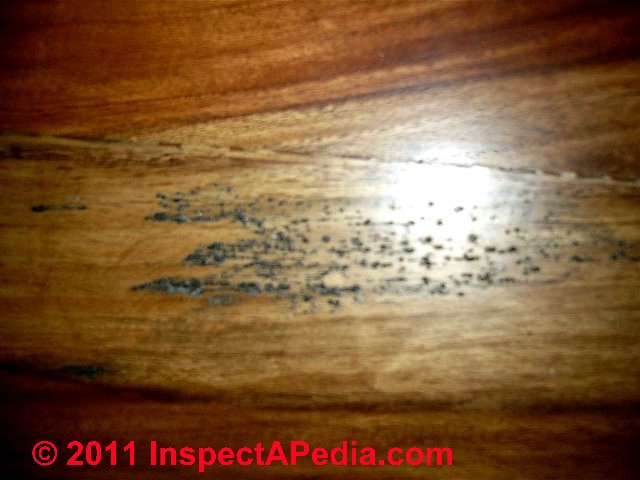
Below the yellow-white mold growing up through the hardwood finished floor is a strong indicator of more significant hidden damage, possibly including Meruliporia incrassata - a source of extensive structural rot in some buildings.
At our picture of moldy flooring shown next (below) we are looking up at the under-side of finish flooring that was installed without a solid subfloor. The blue-green thick mold we sometimes find in this location often is identified in our lab as Trichoderma.
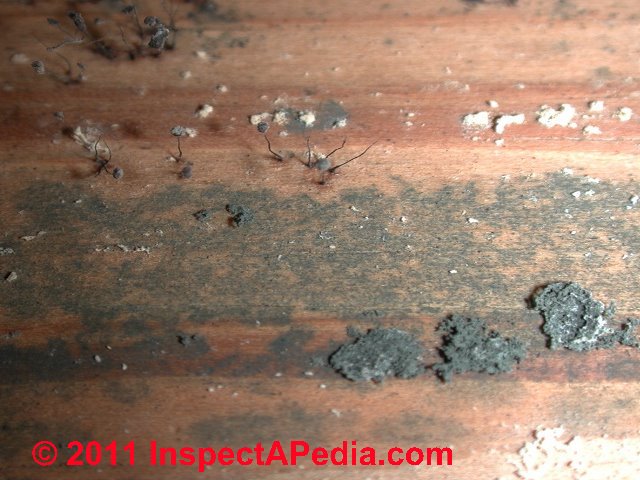
Mold on Flooring, resilient floor covering
The photos just below illustrate Semonitis sp. fungal growth on a resilient bathroom floor covering contributed to us by an Australian reader.
You are looking at the same fungus at two different stages of its growth
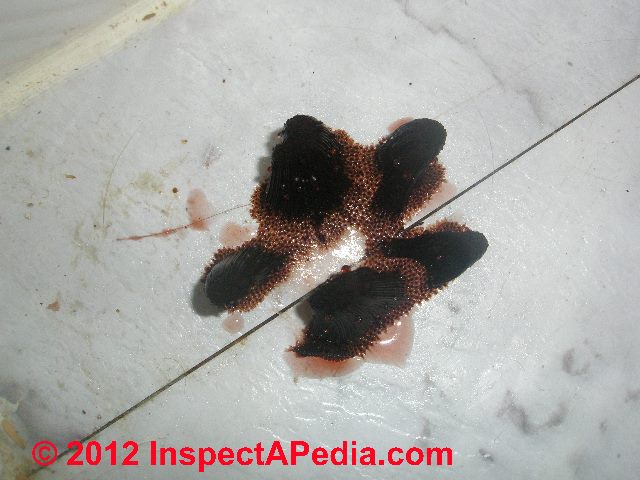
Mold on Framing Lumber, Joists, Studs, I-Joists
Severe mold contamination on floor joists over a flooding basement is shown in our photographs
above and below.
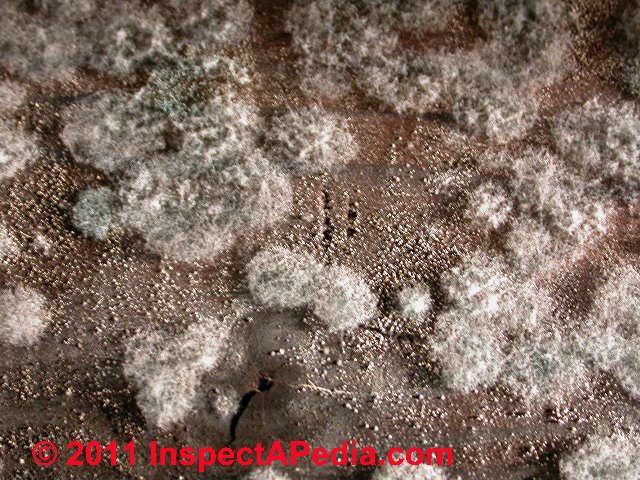
More moldy floor framing
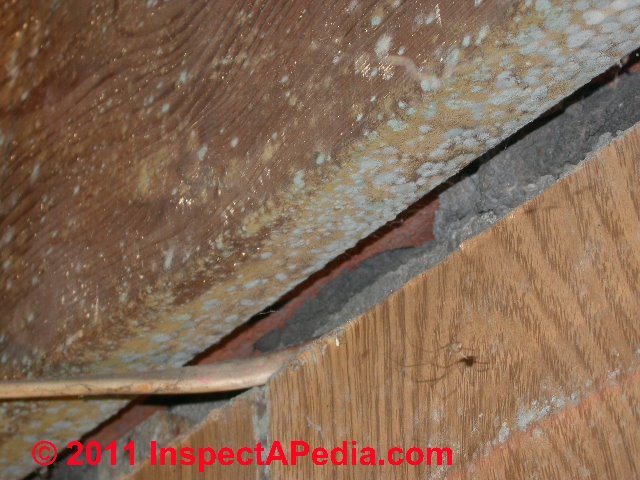
More moldy floor framing includes an area below a protracted leak (below )
and (most likely) cosmetic mold on new framing lumber waiting for use in a reconstruction job for a building that experienced a fire (below right).
Because heat and pressure are involved in the manufacture of engineered wood, I-joists, LVL, web-trusses and other wood truss material and because manufacturers would not be expected to start production with wet wood, it can be a surprise to find mold growth on these structural members; but mold growth does show up on engineered wood, joists, and trusses both before and after their use in construction.
Above: harmless cosmetic dark brown or black mold found on the OSB web of a wood I-Truss at a construction project we worked in 2011.
Except for the dark cosmetic mold in our example-photo above, you can not assume that other mold growth on wood used inside buildings is harmless.
Watch out: We find mold growing on engineered wood I-joists and wood trusses as well; the particular mold genera/species and mold color and location vary and may be affected by the chemistry of the glues or adhesives used in producing engineered wood joists and trusses as well as depending on the conditions of joist or truss transportation and storage or conditions in the building where these framing members have been installed.
Above is an example of white mold contamination growing on the engineered wood chord of an OSB-webbed I-Joist provided by an InspectApedia.com reader and discussed in detail at
WOOD I-JOIST & TRUSS MOLD CONTAMINATION
Mold on Upholstered & Wood Furniture, Game Tables, Croquet Mallets
The game table (above) appeared "clean" to the remediators who left it in a basement during and following a mold remediation job.
But a look underneath the table at its unfinished wood surfaces told a different story (below right).
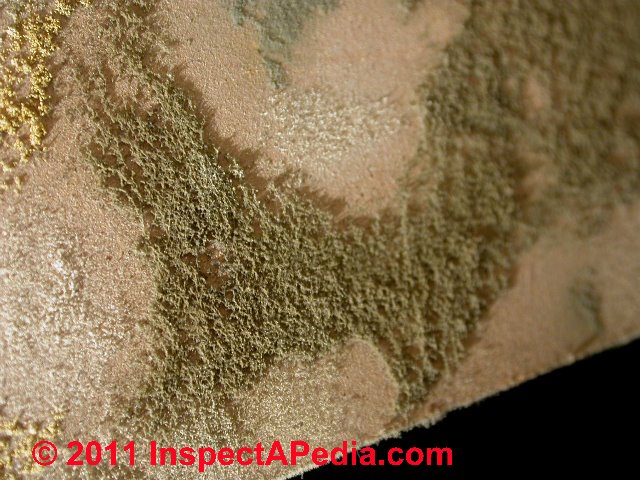
Black mold growth (actually dark brown mold)
was not visible on this livingroom couch set (above) until a closer inspection was made (below).
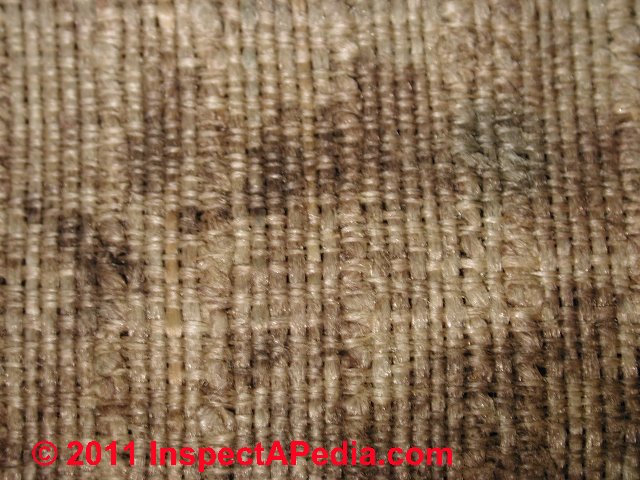
And a still closer look at this fabric illustrates one component of the reason that it is just about impossible to completely clean mold growth from plush upholstered furnishings.
Our second photo (below right) illustrates a dining room chair with dense mold growth on the chair back as well as on the upholstered seat (not visible in our photo).
While it is possible to adequately clean mold off of solid wood surfaces, only if this chair were a valuable antique might it be economically justified to have it stripped, cleaned, and re-upholstered.
The wood buffet in our photos below was exposed to extensive mold growth in a home that was flooded and left for several weeks. The removal of surface mold is not difficult but the removal of mold odors (MVOCs) that remain can be quite a challenge.
If furniture like this is to be cleaned and salvaged special attention will be needed in cleaning the hidden and un-coated wood surfaces such as the under-side of drawers and the frame of the unit, and following cleaning those surfaces will best be treated by coating with a clear sealant as well. More likely the unit is beyond successful cleaning.

Black, green, white mold growth on upholstered furniture is obvious in these two photographs,
of a mold on a leatherette surface (above) and on an upholstered chair (below ).
Watch out: Remember, when looking for mold contamination, to look on the under-side of tables and bureau drawers - surfaces that are often friendly to mold growth even when the painted or sealed visible surfaces are not.
CONTACT us to submit photographs of mold growth on other man-made or building-related materials.
...
Reader Comments, Questions & Answers About The Article Above
Below you will find questions and answers previously posted on this page at its page bottom reader comment box.
Reader Q&A - also see RECOMMENDED ARTICLES & FAQs
Are these little mold spots a worry?
I found this pattern in the dust on some of my wood and fabric surfaces. Is it worrisome? I sprayed it with bleach, but I'm concerned that it will come back. Even worse, now I'm wondering where else it may be that I'm unable to see it.
I have carpeting in much of the house. It's a cement block home in Florida built in 2002. - On 2020-08-02 by Moriah Richardson
Reply by (mod) -
That may be mold, Moriah but from the photo I can't tell if I'm seeing just dust or both mold and dust.
See also WHITE MOLD PHOTOS
Watch out: You will also want to be sure to read BLEACHING MOLD, Advice - as generally that's a bad idea.
Is it possible for white and black mold to grow on stone surfaces of a stone fireplace on the INSIDE, indoors?
Is it possible for white and black mold to grow on stone surfaces of a stone fireplace on the INSIDE, indoors?
This is a camp where the stone fireplace has a propane insert, not used often at all.
This room smells very musty, other rooms do not. Without ripping up wall, ceiling and wood flooring, there is no other immediately visible mold. It's just on this stone fireplace. It is not the "wipe off" white powdery stuff on basement concrete. On 2016-05-10 by deb -
Reply by (mod) - yes but ...
Deb there are fungal species that will grow on almost anything, but usually inside of a home if there is mold growing on stone it's usually growing on something on the stone surface such as organic dust (dog dander), or a coating, or wood particles, dust, soot.
Search InspectApedia.com for WHITE EFFLORESCENCE to see what is often mistaken for mold but is not
Will that white mold come off of the wood completely?
Does that white looking mold in the first picture come completely off, out of the wood, when cleaned or is it senseless to try? On 2015-12-09 by Teresa -
Reply by (mod) - it depends
Teresa,
As my very smart friend Mark Cramer (a Florida home inspector and educator) says, "... it depends"
Light mold growth on a finished surface such as a varnished or lacquered wood chest will often be removed by surface cleaning with a household cleaner.
If the building was very humid mold may have formed even under the finish coating - in which case surface cleaning won't remove the stains.
It makes sense to try cleaning. But it's also important to understand and fix the cause.
...
Continue reading at MOLD GROWTH on SURFACES, PHOTOS_GROUP_6 or select a topic from the closely-related articles below, or see the complete ARTICLE INDEX.
Or see these
Recommended Articles
- ACTION GUIDE - WHAT TO DO ABOUT INDOOR MOLD
- BLACK MOLD, HARMLESS
- MOLD APPEARANCE on VARIOUS SURFACES index to photos of mold on all kinds of surfaces and materials
- MOLD APPEARANCE - WHAT MOLD LOOKS LIKE - home
- MOLD APPEARANCE - STUFF THAT IS NOT MOLD
- MOLD ATLAS & PARTICLES INDEX
- MOLD FREQUENCY in BUILDINGS
- MOLD in BUILDINGS
- MOLD CONTAMINATION IN BUILDINGS - home
- MOLD by MICROSCOPE - mold under the microscope
- MOLD in the PETRI DISH, PHOTOS - mold on culture plates or in culture-type mold test kits
- MOLD RELATED ILLNESS SYMPTOMS
Suggested citation for this web page
MOLD GROWTH on SURFACES, PHOTOS_GROUP_5 at InspectApedia.com - online encyclopedia of building & environmental inspection, testing, diagnosis, repair, & problem prevention advice.
Or see this
INDEX to RELATED ARTICLES: ARTICLE INDEX to MOLD CONTAMINATION & REMEDIATION
Or use the SEARCH BOX found below to Ask a Question or Search InspectApedia
Ask a Question or Search InspectApedia
Try the search box just below, or if you prefer, post a question or comment in the Comments box below and we will respond promptly.
Search the InspectApedia website
Note: appearance of your Comment below may be delayed: if your comment contains an image, photograph, web link, or text that looks to the software as if it might be a web link, your posting will appear after it has been approved by a moderator. Apologies for the delay.
Only one image can be added per comment but you can post as many comments, and therefore images, as you like.
You will not receive a notification when a response to your question has been posted.
Please bookmark this page to make it easy for you to check back for our response.
IF above you see "Comment Form is loading comments..." then COMMENT BOX - countable.ca / bawkbox.com IS NOT WORKING.
In any case you are welcome to send an email directly to us at InspectApedia.com at editor@inspectApedia.com
We'll reply to you directly. Please help us help you by noting, in your email, the URL of the InspectApedia page where you wanted to comment.
Citations & References
In addition to any citations in the article above, a full list is available on request.
- [2] Dictionary of the Fungi, 9th Ed., PM Kirk, PF Cannon, JC David, && JA Stalpers Ed., CABI Publishing 2001 ISBN 0 85199 377 X www.cabi.org UK
- [5] Fungi, Identifying Filamentous, A Clinical Laboratory Handbook, Guy St-Germain, Richard Summerbell, Star Publishing, 1996, ISBN 0-89863-177-7 (English)
- Fungi, Identifying Filamentous, A Clinical Laboratory Handbook, Guy St-Germain, Richard Summerbell, Star Publishing, 1996, ISBN 0-89863-177-7 (English)
- In addition to citations & references found in this article, see the research citations given at the end of the related articles found at our suggested
CONTINUE READING or RECOMMENDED ARTICLES.
- Carson, Dunlop & Associates Ltd., 120 Carlton Street Suite 407, Toronto ON M5A 4K2. Tel: (416) 964-9415 1-800-268-7070 Email: info@carsondunlop.com. Alan Carson is a past president of ASHI, the American Society of Home Inspectors.
Thanks to Alan Carson and Bob Dunlop, for permission for InspectAPedia to use text excerpts from The HOME REFERENCE BOOK - the Encyclopedia of Homes and to use illustrations from The ILLUSTRATED HOME .
Carson Dunlop Associates provides extensive home inspection education and report writing material. In gratitude we provide links to tsome Carson Dunlop Associates products and services.


